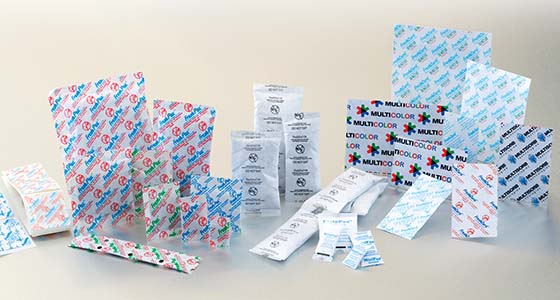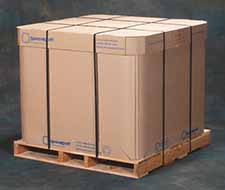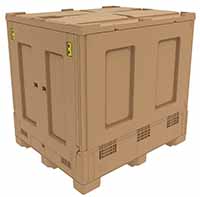New Technologies Signify a Bright Future for Food Packaging
PACKAGING PREVIEW

The Food Packaging Division is being revived under the assertive leadership of Peter Salmon of International Food Network, Valentina Trinetta of Ecolab, and several others. During this year’s annual meeting, the Food Packaging Division, in concert with the Food Processing Division, will offer at least two symposia and one graduate poster session plus a big poster session. In addition, the Food Packaging Division will resume honoring standouts in food packaging with the Riester-Davis Award. Past Riester-Davis award honorees include some of the most outstanding technology drivers in food science and technology: Dick Perdue and Charles Barmore from Cryovac, Ted Labuza and Marc Karel of Massachusetts Institute of Technology, Burt Lundquist of Swift, Mike Gigliotti of Monsanto, and other notables. What a world these professionals have given us. What food packaging futures might debut June 21–24, 2014, in New Orleans, La.?
Research Insights
K. Bhunia, B. Rasco, J. Tang, and S.S. Sablani of Washington State University will present “Understanding the Influence of Package Film Oxygen Transmission Rate on Lipid Oxidation and Oxygen Reduction Potential of Pasteurized Blue Mussels in Red Sauce: A Storage Study” on Saturday, June 21, from 1 p.m. to 2:30 p.m. The paper will cover how multilayer nylon films were employed to lid plastic trays of product stored under refrigeration.
C. Saada, B. Annous, L. Liu, and K. Yam of Rutgers University and the U.S. Dept. of Agriculture will present “System Feasibility: Designing a Chlorine Dioxide Self-Releasing Package Label” on Saturday, June 21, from 1 p.m. to 2:30 p.m. The paper will focus on how labels were fabricated from synthetic and biodegradable polymers in which chlorine dioxide precursors were incorporated by coating. Heat was applied to activate the chlorine dioxide whose effectiveness against a Salmonella culture was measured.
S. Shayanfar, B. Smith, and S.D. Pillai from Texas A & M University’s National Center for Electron Beam Research will present “Bioplastics and MAP to Enhance Sustainable Packaging and Food Quality: The Role of Electron Beam Technology as a Platform Technology Enhancing Packaging Materials and Food Quality” on Saturday, June 21, from 1 p.m. to 2:30 pm. Their research appears to demonstrate synergies between EB treatment and MAP for packaging of strawberries, tomatoes, grapes, and watermelon.
A. Song, Y. Oh, and S. Min of Seoul Women’s University in South Korea will present “Effects of Cold Plasma Treatments on the Tensile, Moisture Barrier, and Optical Properties of Polyhydroxybutyrate and Polylactic Acid Films” on Saturday, June 21, from 1 p.m. to 2:30 p.m. Their research data appear to suggest that desirable properties of the named plastic films may be enhanced by cold plasma treatments.
Seafood Packaging Indicates a Dramatic Future
On Tuesday, June 24, from 10:30 a.m. to 12 p.m., Riester-Davis Award recipient Barbara Blakistone and Alex Oliveira will moderate session 214, “Seafood Packaging from Around the World to Out of this World.” Joe Marcy of Virginia Tech, also a Riester-Davis awardee, will discuss “Making Smart Packaging Smarter for Today’s Markets” to cross-link food preservation requirements with package properties. Michele Perchonok of the U.S. National Aeronautics and Space Adminisitration will present “We Have a Challenge and It’s Food Packaging,” during which she will summarize the search for high-barrier package materials. And M. Barnekow of BluWrap will expound on the application of controlled atmosphere packaging on fresh fish, specifically Chilean salmon, and fillet distribution over a 60-day period during “Solutions in Environmental Impact of Seafood Imports.”
--- PAGE BREAK ---
Links to Food Processing
In conjunction with Nonthermal Processing and Food Engineering Divisions, the Food Packaging Division’s Hussein Daryaei and Christopher Doona will moderate session 091, “Packaging Systems for Advanced Food Preservation Technologies” on Monday, June 23, from 10:30 a.m. to 12 p.m. Among the topics to be addressed are packaging structures for ultra-high pressure processing, ohmic heating, pulsed electric, microwave, ozone, and chlorine dioxide treatment. Y. Song will discuss “The Effect of High-Pressure Processing on Migration Characteristics in Polymer Films.” This research studied additive migration from polymers attributable to HPP processing. Results indicated that HPP significantly decreased migration of surrogates into food stimulants.
S. Sablani will review “Polymer Packaging for Microwave-Assisted Thermal Processes.” Sablani will delve into research on the packaging components of microwave sterilization at Washington State University. Thermal resistance and shelf life performance of multi-layer package structures during and after microwave processing are relevant topics.
Smart Packaging Gets Smarter with Each Passing Period
And Christopher Doona of U.S. Army Natick Soldier RD&E Center will present “Novel Packaging for Innovative Chlorine Technologies for Fresh Product Safety and Shelf-Life Extension.” This presentation will focus on controlled release antimicrobial packaging that prevents mold growth and extends safe shelf life of fresh berries and other perishable produce and decontaminates bacterial spores. The technology cited is a portable chemical sterilizer disinfectant sprayer derived from medical applications. Chlorine dioxide’s newfound efficacies have made it popular at this year’s IFT annual meeting.
Active and Intelligent Packaging
During session 008 on Sunday, June 22, from 10:30 a.m. to 12 p.m., K. Cooksey of Clemson University will present “State of the Art in Active and Intelligent Packaging and Future Innovations.” Cooksey, another Riester-Davis Award recipient, will discuss how industry demand has spurred considerable growth from laboratory to commercial production. Tom Dunn will present “Commercial Applications of Active and Intelligent Packaging,” when he will discuss a vision of the future.
M. Sunil of California State University will look into the effect of mode of incorporation of antimicrobials onto prepared film versus into film forming matrix on initial and retained antimicrobial activity for her presentation during session 008, and Maxine Roman of the University of Massachusetts will discuss “Non-Migratory Metal Chelating Active Packaging.” Metal chelating agents are grafted from food contact surfaces of polymer films to chelate iron from model food systems and inhibit lipid oxidation in emulsions.
Poster Sessions
The Food Packaging Division’s poster sessions on Sunday afternoon, June 22, will cover a variety of topics:
• Development of double-layer antimicrobial films using corona treatment
• Multi-metal ion-based ethylene biosensors
• Whey protein-based nanocomposite coatings
• Incorporation of essential oils into wheybased films to enhance shelf life of contained cheese
• Chitosan-based films and coatings and their properties
• Antimicrobial packaging to help preserve surimi, applying ethylene vinyl alcohol incorporating epsilon-polylysine
• Active packaging of bread with antimicrobial based on wheat protein and cinnemaldehyde
• Intelligent kimchi containers based on carbon dioxide absorption
• Bioplastics and MAP to enhance sustainability and food quality: electron beam technology as a platform technology.
• Shelf life extension of custard using edible films and active packaging
• Shelf life prediction of new packaging containers for breakfast cereals
This list implies that the future of food packaging could be edible packaging and natural antimicrobials.
--- PAGE BREAK ---
Exhibitor Information
The following are brief descriptions of some of the packaging-related exhibitors at the 2014 IFT Annual Meeting & Food Expo.
Food and beverage sorbent solutions and systems from Multisorb Technologies can be broken out into three platforms: Drop-In, Fit-In, and Built-In. Drop-In products, including FreshPax®, MiniPax®, and StripPax®, are dropped into a package or container and function to protect food from the effects of moisture and oxidation. Applications include processed meats, bakery products, nuts, and confections. FreshCard® oxygen-absorbing cards and FreshMax® self-adhesive oxygen absorbers, which are categorized as Fit-In solutions, preserve the flavor, color, aroma, and shelf life of processed meats, baked goods, dairy products, and snack foods, among other products. Finally, the company’s Built-In platform offers sorbent properties integrated into molded parts or packaging film. Multisorb Technologies, www.multisorb.com, Booth 1817
 A disposable intermediate bulk container (IBC) from International Paper, SpaceKraft® is engineered for liquids and complies with FDA, USDA and Kosher food safety requirements. SpaceKraft is available for a wide range of food ingredients, including glycerin, edible oils, salad dressings, liquid sweeteners, and flavorings. With seven times the insulation factor of drums and other plastic IBCs, SpaceKraft containers are built to withstand temperature extremes for aseptically packaged juices and purees. The package is offered in footprints that match a broad range of pallet and shipping specifications. A leading global supplier of fiber-based packaging, International Paper offers a complete line of bulk packaging products for food applications. International Paper, www.spacekraft.com, www.internationalpaper.com/bulkpackaging, Booth 2343
A disposable intermediate bulk container (IBC) from International Paper, SpaceKraft® is engineered for liquids and complies with FDA, USDA and Kosher food safety requirements. SpaceKraft is available for a wide range of food ingredients, including glycerin, edible oils, salad dressings, liquid sweeteners, and flavorings. With seven times the insulation factor of drums and other plastic IBCs, SpaceKraft containers are built to withstand temperature extremes for aseptically packaged juices and purees. The package is offered in footprints that match a broad range of pallet and shipping specifications. A leading global supplier of fiber-based packaging, International Paper offers a complete line of bulk packaging products for food applications. International Paper, www.spacekraft.com, www.internationalpaper.com/bulkpackaging, Booth 2343
Portable stainless steel totes from CCR are certified for transport and storage of a wide variety of liquids. The containers are available for lease with terms of one to eight years with no deposit required. All leases are supported by the company’s technical and commercial team. CCR Containers USA, www.ccrcontainers.com, Booth 516
Reusable liquid bulk packaging is available for rental from TPS Rental Systems LLC. The product assortment includes steel and plastic intermediate bulk containers, liquid liner bags, and bag-in-box systems in sizes from 66 gal to 264 gal. Application-specific valves, flanges, and accessories are featured. TPS Rental Systems LLC, www.tpsrentalsystems-us.com, Booth 5418
Standard and custom desiccants from Desiccare Inc., a leading supplier of controlled atmosphere packaging, are available for food and pharmaceutical applications. Desiccare Inc., www.dessiccare.com, Booth 1504
 A specialty bulk box, Intrepid is 48” x 40” in size and designed for liquid, semi-liquid, powder, granular, and meat/poultry applications. Made of reusable plastic , it is FDA-approved, completely recyclable, and capable of handling loads of up to 2,500 lbs. Stackable with or without lids, the container features non-sequential folding panels that can be assembled or collapsed in seconds. Buckhorn Inc., www.buckhorninc.com, Booth 1600
A specialty bulk box, Intrepid is 48” x 40” in size and designed for liquid, semi-liquid, powder, granular, and meat/poultry applications. Made of reusable plastic , it is FDA-approved, completely recyclable, and capable of handling loads of up to 2,500 lbs. Stackable with or without lids, the container features non-sequential folding panels that can be assembled or collapsed in seconds. Buckhorn Inc., www.buckhorninc.com, Booth 1600
 Aaron L. Brody, Ph.D., CFS, Contributing Editor
Aaron L. Brody, Ph.D., CFS, Contributing Editor
President and CEO, Packaging/Brody Inc., Duluth, Ga.,
and Adjunct Professor, University of Georgia
[email protected]
